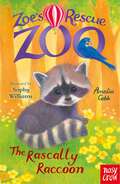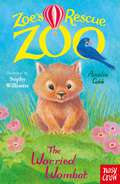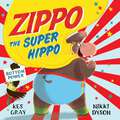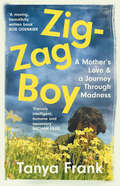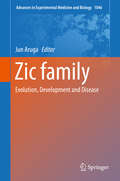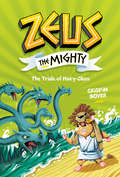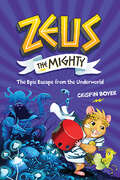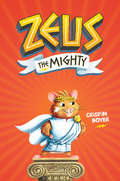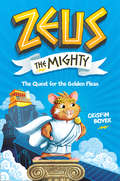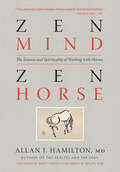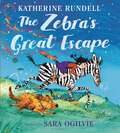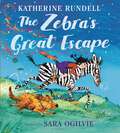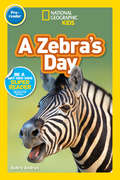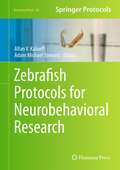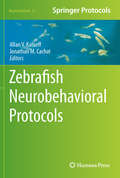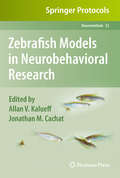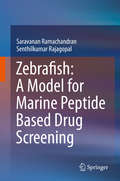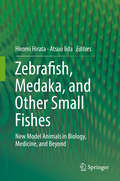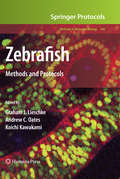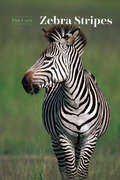- Table View
- List View
Zoe's Rescue Zoo: The Rascally Raccoon (Zoe's Rescue Zoo #24)
by Amelia CobbAt Zoe's Rescue Zoo only the cutest, cuddliest animals need apply! Zoe loves living at her uncle's rescue zoo because there's always something exciting going on. And Zoe also has an amazing secret... She can actually TALK to the animals! Rocco the raccoon has just arrived at the zoo and he loves to play pranks! Inspired by the rascally animal, Zoe and her friend decide to play their own. But when a prank goes too far, Zoe will need Rocco's help to make things right. Another fantastic title in the perfect series for young animal lovers, beautifully illustrated throughout by Sophy Williams.
Zoe's Rescue Zoo: The Worried Wombat (Zoe's Rescue Zoo)
by Amelia CobbAt Zoe's Rescue Zoo only the cutest, cuddliest animals need apply! Zoe loves living at her uncle's rescue zoo because there's always something exciting going on. And Zoe also has an amazing secret... She can actually TALK to the animals! Zoe's thrilled to welcome a new wombat family to the zoo! But when Winnie is separated from her mum, can Zoe help the little wombat feel safe in her new home? Another fantastic title in the perfect series for young animal lovers, beautifully illustrated throughout by Sophy Williams. Have you read Zoe's other adventures? Check out The Rascally Raccoon, The Adventurous Arctic Fox , The Runaway Reindeer , The Talkative Tiger and many more titles!
Zippo the Super Hippo (Zippo the Super Hippo #1)
by Kes GrayZippo doesn't want to be an ordinary hippo. He wants to be super! "Everyone has a super power," says his best friend Roxi. "You just have to work out what yours is." Being good at swimming and splashing in mud aren't really superpowers though. Perhaps Zippo can fly like Roxi. But who's ever heard of a flying hippopotamus? Especially one with such a big bottom. Maybe there's a power in that . . .From award-winning author Kes Gray and exciting new illustrating talent Nikki Dyson. This fantastically funny superhero will be flying into children's imaginations and inspiring them to celebrate all that is super about themselves.
Zinc in Soils and Plants: Proceedings of the International Symposium on ‘Zinc in Soils and Plants’ held at The University of Western Australia, 27–28 September, 1993 (Developments in Plant and Soil Sciences #55)
by A. D. RobsonProceedings of the International Symposium on `Zinc in Soils and Plants', held at The University of Western Australia, Perth, Western Australia, 27--28 September 1993
Zig-Zag Boy: Madness, Motherhood And Letting Go
by Tanya Frank‘[A] moving, beautifully written book about love and mental health and life’ BOB ODENKIRK ‘Fiercely intelligent, humane and necessary’ NATHAN FILER, author of THE SHOCK OF THE FALL 'At its heart a story about love … an astonishing new voice' ALI MILLAR, author of THE LAST DAYS
Zic family: Evolution, Development and Disease (Advances in Experimental Medicine and Biology #1046)
by Jun ArugaThis book provides a comprehensive overview of ZIC-family research. Part1 summarizes the ZIC family in animal evolution and development and presents an overall picture of the ZIC family gene structure in eumetazoan animals, providing an evolutionary hypothesis and reviewing the studies on the role of ZIC family proteins in developmental processes for each animal model. Part 2 shows that the ZIC family are the causative genes for developmental disorders, and discusses the role of the ZIC family in stem cell biology. It also presents studies on the ZIC family in the medical biology field. This interdisciplinary book is a valuable resource not only for those people directly involved in ZIC-family-related research, but also researchers in diverse research fields who are interested in the latest advances in biology and medicine.
Zeus the Mighty: The Trials of Hairy-Clees (Zeus the Mighty)
by National Geographic KidsZeus the hamster and his "god squad" are back to battle for the title of champion in the third title in this series that takes readers on a rollicking romp through Greek mythology.
Zeus the Mighty: The Epic Escape from the Underworld (Zeus the Mighty)
by National Geographic KidsZeus the hamster and his team of Olympians journey deep into the Underworld in the fourth title of this fun-filled, Greek-mythology-based series.
Zeus The Mighty 2 (Zeus Ser.)
by National Geographic Kids Crispin BoyerLeap into the world of Zeus the hamster and his gang of gods as they solve the mystery of the labyrinth in the second book in this hilarious modern-day take on Greek mythology.
Zeus The Mighty
by National Geographic Kids Crispin BoyerGreek mythology meets The Secret Life of Pets in this first adventure in a new middle grade fiction series, starring Zeus, the mighty hamster, and the crazy crew of critters of the Mount Olympus Pet Supply Shop.
Zen Mind, Zen Horse: The Science and Spirituality of Working with Horses
by Allan J. Hamilton MDDrawing on his scientific understanding of the brain, noted neurosurgeon and lifelong horseman Allan Hamilton offers a new approach to horse training based on understanding the intuitive, nonverbal, right-brain communication process of horses.
Zell- und Molekularbiologie im Überblick
by Daniel Boujard Bruno Anselme Christophe Cullin Céline Raguénès-NicolDieses Buch gibt einen Überblick über die Gebiete der Zellbiologie und der Molekularbiologie (Genexpression, Kompartimentierung, Bioenergetik, Immunsystem etc.) sowie die entsprechenden experimentellen Methoden (Elektrophorese, Immunopräzipitation, Fluoreszenz etc.). Die Darstellung ist an die Bedürfnisse der Studierenden angepasst, die sich auf eine Prüfung vorbereiten: Übersichtliche Zusammenfassungen ermöglichen ein effizientes Erlernen des Stoffs, der anhand von Multiple-Choice-Fragen und den korrekten Antworten überprüft werden kann.Highlights des Buches:200 Themen der Zell- und Molekularbiologie in leicht zu erlernenden ZusammenfassungenÜbersichtliche Kurzkapitel mit zweifarbigen AbbildungenÜber 160 Multiple-Choice-Fragen mit präzisen AntwortenBiomedizinischer Fokus
The Zebra's Great Escape
by Katherine Rundell**A TIMES CHILDREN'S BOOK OF THE WEEK****'A writer of boundless gifts and extraordinary imaginative power' - Observer**Mink doesn't believe in rules. She loves running wild and free. So, when a zebra appears in the square where she lives and she finds out that his parents have been captured by the evil Mr Spit, she knows that it's up to her to help. So begins a grand adventure to rescue a whole menagerie of animals – an adventure that will take all of Mink's courage and determination. Written with generous helpings of warmth and humour, this is a timeless picture book about bravery, friendship and the importance of taking action. With stunning illustrations by award-winning illustrator Sara Ogilvie, illustrator of The Detective Dog, this modern classic from bestselling children's author Katherine Rundell is an unmissable treat.
The Zebra's Great Escape
by Katherine Rundell_______________A TIMES CHILDREN'S BOOK OF THE WEEK'A writer of boundless gifts and extraordinary imaginative power' - Observer'A writer with an utterly distinctive voice and wild imagination' - Philip Pullman'Read everything she writes' - Daily Mail_______________Mink doesn't believe in rules. She loves running wild and free. So, when a zebra appears in the square where she lives and she finds out that his parents have been captured by the evil Mr Spit, she knows that it's up to her to help. So begins a grand adventure to rescue a whole menagerie of animals – an adventure that will take all of Mink's courage and determination. Written with generous helpings of warmth and humour, this is a timeless picture book about bravery, friendship and the importance of taking action. With stunning illustrations by award-winning illustrator Sara Ogilvie, illustrator of The Detective Dog, this modern classic from bestselling children's author Katherine Rundell is an unmissable treat.
A Zebra’s Day (National Geographic Readers)
by National Geographic Kids Aubre AndrusFollow a zebra throughout the day as it grazes and spends time with its herd in its grassland habitat. Through engaging text features, such as the vocabulary tree and the wrap-up activity, kids will be introduced to vocabulary in concept groups, helping them make connections between words and expanding their understanding of the world.
Zebrafish Protocols for Neurobehavioral Research (Neuromethods #66)
by Allan V. Kalueff and Adam Michael StewartZebrafish (Danio rerio) play an integral role in biomedical research, enabling researchers to examine physiological mechanisms and pathways relevant to human pathogenesis and its therapy. That, along with their low cost, easy manipulation, short reproductive cycles, and physiological homology to humans, has made zebrafish a vital model organism for neuroscience research. Zebrafish Protocols for Neurobehavioral Research addresses protocols for both larval and adult models, written by the leading experts in the field of zebrafish research. Part I of this book takes advantage of the high-throughput nature of larval models to offer protocols for research requiring high output, easily manipulated screens. The second half of the book focuses on the robust and sophisticated behaviors of adult zebrafish, suitable for the neurophenotyping of complex traits and multi-domain disorders. Importantly, these models complement each other, working together to provide researchers with valuable insights into neurobiology of normal and pathological behavior. Thorough and cutting-edge, this volume is a useful, authoritative reference guide that should hold a coveted spot in zebrafish laboratories across the globe.
Zebrafish Neurobehavioral Protocols (Neuromethods #51)
by Allan V. Kalueff and Jonathan M. CachatAs a model organism, zebrafish (Danio rerio) offer an opportunity to perform steadfast scientific investigations in a robust and high-throughput manner. In Zebrafish Neurobehavioral Protocols, experts in the field provide a series of detailed behavioral protocols dealing with the major current research areas in the field of behavioral neuroscience. The chapters discuss the use and interpretation of video-aided quantification of zebrafish behaviors, describe novel assays commonly used to quantify emotionality, learning, memory, and social behaviors in zebrafish, and instruct how to quantify endocrine responses and correlate them with behavior. Written in the Neuromethods series format, the chapters provide authoritative reviews of many commonly used approaches in the field today. This "how to" book will be a useful practical guide for zebrafish researchers and will complement another related book from this series, Zebrafish Models in Neurobehavioral Research. Cutting-edge and timely, Zebrafish Neurobehavioral Protocols serves as an excellent compilation epitomizing the growing potential of zebrafish in modern scientific inquiry.
Zebrafish Models in Neurobehavioral Research (Neuromethods #52)
by Allan V. Kalueff and Jonathan M. CachatAnimal models have traditionally played a crucial role in improving our understanding of brain pathogenesis. Zebrafish (Danio rerio) have generated considerable discoveries in the areas of genetics, embryology, endocrinology, and neuroscience. Zebrafish Models in Neurobehavioral Research emphasizes the growing importance of zebrafish in neurobehavioral research and portrays an extensive, thorough perspective on the emergence of zebrafish as robust and translational models. Written by leading international experts, the book covers major topics ranging from stress to learned recognition of environment, encompassing a wide spectrum of the utility of zebrafish within neurobiological disciplines. The chapters provide authoritative reviews of many zebrafish paradigms commonly used in the field today. This book will be a useful guide for zebrafish researchers, and will complement another related book from the popular Neuromethods series, Zebrafish Neurobehavioral Protocols. Comprehensive and up-to-date, Zebrafish Models in Neurobehavioral Research serves as an ideal resource for scientists new to the field as well as for established researchers seeking valuable insight into the growing utility of zebrafish in neuroscience.
Zebrafish: A Model for Marine Peptide Based Drug Screening
by Saravanan Ramachandran Senthilkumar RajagopalThis book offers a comprehensive overview of toxicology, highlighting the significance of peptide-based toxins from marine environments. It discusses the principles of protein-carbohydrate and domain-domain interactions to increase our understanding of toxicology in zebrafish models, as well as drug interaction mechanisms and target definition in drug discovery. It also reviews the structure of marine peptides/toxins and the toxicology of peptide secreting cells and cells that respond to these enzymes, and describes the normal and abnormal toxicology of marine peptides in zebrafish models. Offering insights into the field of proteomics, particularly current practice and research models for solving its many riddles, the book also explains the analytical principles of marine protein-protein and protein-carbohydrate interaction in the context of teratogenicity in target identification in peptide- based drug discovery. Lastly, the book methodically examines the preclinical research on marine proteins/peptides.
Zebrafish, Medaka, and Other Small Fishes: New Model Animals in Biology, Medicine, and Beyond
by Hiromi Hirata Atsuo IidaThis book provides cutting-edge studies and technologies using small fishes, including zebrafish, medaka, and other fishes as new model animals for molecular biology, developmental biology, and medicine. It also introduces eccentric fish models that are pioneering new frontiers of biology.Zebrafish and medaka have been developed as lower vertebrate model organisms because these small fish are easy to raise in the laboratory and are useful for the live imaging of the morphology and activity of cells and tissues in intact animals. By virtue of those specific advantages, fish studies have demonstrated the common features of vertebrates and raised further questions toward understanding the mystery of life.The book consists of four parts: “Development and Cell Biology”, “Homeostasis and Reproduction”, “Clinical Models”, and “Eccentric Fish”. Together they describes the core area of small fish study – often considered mere zoology but which is actually proving to be the universal basis of life.Written by leading scientists, the book helps readers to understand small fishes, inspires scientists to utilize small fishes in their studies, and encourages anyone who wants to participate in the large and fantastic world of small fish.
Zebrafish: Methods and Protocols (Methods in Molecular Biology #546)
by Graham J. Lieschke, Andrew C. Oates and Koichi KawakamiIn the last 20 years, research activity using the zebrafish Danio rerio has increased dramatically, due in part to the ease of breeding and raising them, their genetic tractability, embryonic accessibility, and their imaging potential. In Zebrafish: Methods and Protocols, expert researchers provide a collection of experimental techniques for the genetic modification, manipulation, and in vivo live imaging of zebrafish. This volume collects sophisticated and practical techniques, including several not yet widely known, from laboratories around the world. Written in the highly successful Methods in Molecular Biology™ series format, chapters include brief introductions to their respective topics, lists of the necessary materials and reagents, step-by-step, readily reproducible laboratory protocols, and notes on troubleshooting and avoiding known pitfalls. Authoritative and accessible, Zebrafish: Methods and Protocols seeks to aid and inspire scientists utilizing this versatile animal model in their research.
Zebra (UEB uncontracted)
This zebra is shown from the side, with its head at the right of the page and its tail at the left. There is a locator dot shown, which will be at the top left of the page when the image is the right way up. The zebra has its head turned to face you. A zebra is similar to a horse, but has stripes covering its body. Its head has two ears sticking out at the top, two small eyes in the middle and two nostrils at the bottom. Its mouth is just below its nostrils but is not shown on the image. To the left of the head is the neck with its hairy mane sticking up on top. To the left of the neck is the body of the zebra, standing on all four legs, each with hooves. On the left of the page is the tail with a little tuft of hair at the end.
Zebra (UEB contracted)
This zebra is shown from the side, with its head at the right of the page and its tail at the left. There is a locator dot shown, which will be at the top left of the page when the image is the right way up. The zebra has its head turned to face you. A zebra is similar to a horse, but has stripes covering its body. Its head has two ears sticking out at the top, two small eyes in the middle and two nostrils at the bottom. Its mouth is just below its nostrils but is not shown on the image. To the left of the head is the neck with its hairy mane sticking up on top. To the left of the neck is the body of the zebra, standing on all four legs, each with hooves. On the left of the page is the tail with a little tuft of hair at the end.
Zebra Stripes
by Tim CaroFrom eminent biologists like Alfred Russel Wallace and Charles Darwin to famous authors such as Rudyard Kipling in his Just So Stories, many people have asked, “Why do zebras have stripes?” There are many explanations, but until now hardly any have been seriously addressed or even tested. In Zebra Stripes, Tim Caro takes readers through a decade of painstaking fieldwork examining the significance of black-and-white striping and, after systematically dismissing every hypothesis for these markings with new data, he arrives at a surprising conclusion: zebra markings are nature’s defense against biting fly annoyance. Popular explanations for stripes range from camouflage to confusion of predators, social facilitation, and even temperature regulation. It is a serious challenge to test these proposals on large animals living in the wild, but using a combination of careful observations, simple field experiments, comparative information, and logic, Caro is able to weigh up the pros and cons of each idea. Eventually—driven by experiments showing that biting flies avoid landing on striped surfaces, observations that striping is most intense where biting flies are abundant, and knowledge of zebras’ susceptibility to biting flies and vulnerability to the diseases that flies carry—Caro concludes that black-and-white stripes are an adaptation to thwart biting fly attack. Not just a tale of one scientist’s quest to solve a classic mystery of biology, Zebra Stripes is also a testament to the tremendous value of longitudinal research in behavioral ecology, demonstrating how observation, experiment, and comparative research can together reshape our understanding of the natural world.
Zebra Stripes
by Tim CaroFrom eminent biologists like Alfred Russel Wallace and Charles Darwin to famous authors such as Rudyard Kipling in his Just So Stories, many people have asked, “Why do zebras have stripes?” There are many explanations, but until now hardly any have been seriously addressed or even tested. In Zebra Stripes, Tim Caro takes readers through a decade of painstaking fieldwork examining the significance of black-and-white striping and, after systematically dismissing every hypothesis for these markings with new data, he arrives at a surprising conclusion: zebra markings are nature’s defense against biting fly annoyance. Popular explanations for stripes range from camouflage to confusion of predators, social facilitation, and even temperature regulation. It is a serious challenge to test these proposals on large animals living in the wild, but using a combination of careful observations, simple field experiments, comparative information, and logic, Caro is able to weigh up the pros and cons of each idea. Eventually—driven by experiments showing that biting flies avoid landing on striped surfaces, observations that striping is most intense where biting flies are abundant, and knowledge of zebras’ susceptibility to biting flies and vulnerability to the diseases that flies carry—Caro concludes that black-and-white stripes are an adaptation to thwart biting fly attack. Not just a tale of one scientist’s quest to solve a classic mystery of biology, Zebra Stripes is also a testament to the tremendous value of longitudinal research in behavioral ecology, demonstrating how observation, experiment, and comparative research can together reshape our understanding of the natural world.
